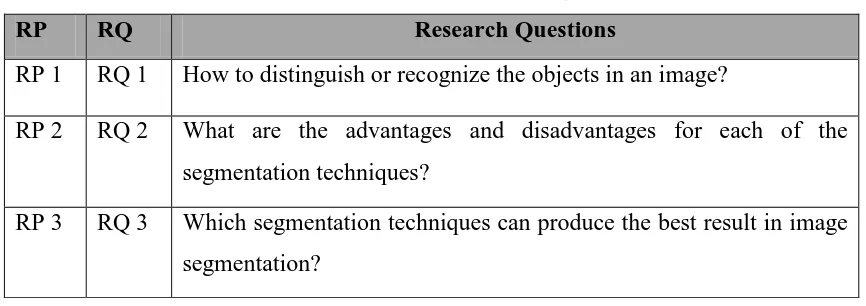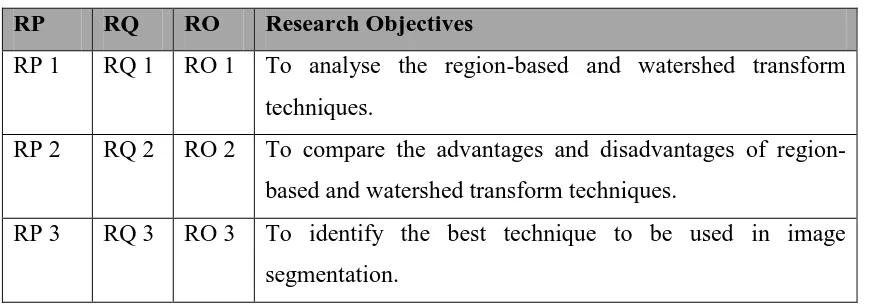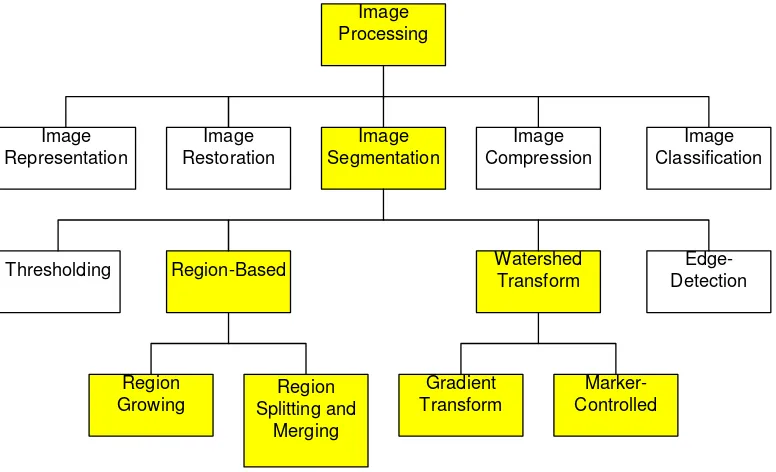BORANG PENGESAHAN STATUS TESIS
JUDUL: THE SEGMENTATION OF SATELLITE IMAGE USING REGION-BASED AND WATERSHED TRANSFORM TECHNIQUES.
SESI PENGAJIAN: SESI 2012/2013
Saya CHAI SIAO LING mengaku membenarkan tesis (PSM/Sarjana/Doktor Falsafah) ini disimpan di Perpustakaan Fakulti Teknologi Maklumat dan Komunikasi dengan syarat-syarat kegunaan seperti berikut:
1. Tesis dan projek adalah hakmilik Universiti Teknikal Malaysia Melaka.
2. Perpustakaan Fakulti Teknologi Maklumat dan Komunikasi dibenarkan membuat salinan untuk tujuan pengajian sahaja.
3. Perpustakaan Fakulti Teknologi Maklumat dan Komunikasi dibenarkan membuat salinan tesis ini sebagai bahan pertukaran antara institusi pengajian tinggi.
4. ** Sila tandakan (/)
_____________ SULIT (Mengandungi maklumat yang berdarjah keselamatan atau kepentingan Malaysia seperti yang termaktub di dalam AKTA RAHSIA RASMI
1972)
_____________ TERHAD (Mengandungi maklumat TERHAD yang telah ditentukan oleh organisasi/badan di mana penyelidikan dijalankan)
_____/_______ TIDAK TERHAD
__________________________ ___________________________ (TANDATANGAN PENULIS) (TANDATANGAN PENYELIA)
Alamat tetap :60A, Lorong 2, 17th miles En.Othman bin Mohd ___ Kampung Siburan, 94200 Kuching, Nama Penyelia
Sarawak, Malaysia
THE SEGMENTATION OF SATELLITE IMAGE USING REGION-BASED AND WATERSHED TRANSFORM TECHNIQUES.
CHAI SIAO LING
This report is submitted in partial fulfillment of the requirement for the Bachelor of Computer Science (Computer Networking)
FACULTY OF INFORMATION AND COMMUNICATION TECHNOLOGY UNIVERSITI TEKNIKAL MALAYSIA MELAKA
i
DECLARATION
I hereby declare that this project entitled
THE SEGMENTATION OF SATELLITE IMAGE USING REGION-BASED AND WATERSHED TRANSFORM TECHNIQUES
is written by me and is my own effort and that no part has been plagiarized without citations
STUDENT: ___________________________ DATE: _________________ (CHAI SIAO LING)
DEDICATION
Dear Parent
Thank you for your incessant support and encouragement. Your sacrifices and loves have helped me to achieve this accomplishment.
Dear Teachers and Supervisors
Thank you for your continuous support ,knowledge and guidance.
Dear Friends
iii
ACKNOWLEDGEMENTS
I would like to convey my thanksgiving and appreciation to my supervisor, En.Othman bin Mohd for your guidance by providing me the opinions and suggestions as well as advices throughout the project.
I would also like to thank my parents for giving me varieties of moral supports and all kind of material supports throughout my years pursuing in this university.
Last but not least, I would like to give a big thanks to all my friends and course mates for their grace and kindnessin sharing information and resources.
ABSTRACT
v
ABSTRAK
Pembahagian gambar merupakan bahagian utama image processing dengan membahagikan gambar kepada beberapa bahagian mengikut jenis objek dalam gambar tersebut. Objektif pembahagian gambar adalah untuk membantu manusia mangenal sesuatu gambar yang tidak dikenali dengan lebih senang. Berdasarkan projek ini, pembahagian gambar yang dikeluarkan untuk membuat analisis berdasarkan region-based dan watershed transform teknik. Teknik-teknik ini dibuat analisis yang lebih mendalam untuk mengenal pasti teknik yang terbaik digunakan dalam pembahagian gambar. Pada penghujung projek ini, perbandingan kebaikan dan keburukan antara region-based dan watershed transform teknik akan dijalankan. Oleh itu, teknik pembahagian gambar yang terbaik boleh dikenal pasti dan digunakan untuk pelbagai tujuan.
TABLE OF CONTENTS
CHAPTER SUBJECT PAGE
DECLARATION i
DEDICATION ii
ACKNOWLEDGMENT iii
ABSTRACT iv
ABSTRAK v
TABLE OF CONTENTS vi
LIST OF TABLES x
LIST OF FIGURES xi
LIST OF ABBREVIATIONS xiv
CHAPTER 1 INTRODUCTION
1.1 Project Background 1
1.2 Problem Statement 2
1.3 Research Questions 3
1.4 Objectives 4
1.5 Scopes 5
1.6 Project Significance 5
1.7 Expected Result 6
1.8 Conclusion 6
CHAPTER 2 LITERATURE REVIEW
2.1 Introduction 7
vii
2.2.1 Image Processing Definition 10 2.2.2 Image Segmentation Definition 11 2.2.3 Image Segmentation based on Region-based 13
2.2.3.1 Region Growing 13
2.2.3.2Region Splitting and Merging 15 2.2.4 Image Segmentation based on Watershed
Transform 17
2.2.4.1 Gradient Transform 20
2.2.4.2 Marker-Controlled 20
2.3 Summary 20
CHAPTER 3 METHODOLOGY
3.1 Introduction 21
3.2 Problem Methodology 22
3.3 Project Schedule and Milestones 27
3.3.1 PSM 1 Milestone 27
3.3.2 PSM 2 Milestone 29
3.3.3 Activities Milestone in PSM 1 30 3.3.4 Activities Milestone in PSM 2 33
3.4 Summary 34
CHAPTER 4 PROJECT IMPLEMENTATION
4.1 Introduction 36
4.2 Project Requirement 36
4.2.1 Software Requirement 37
4.2.2 Hardware Requirement 38
4.3 Segmentation Techniques Algorithm 38 4.3.1 Watershed Transform Segmentation 40 4.3.1.1 Gradient Transform Algorithm 41 4.3.1.2 Marker-Controlled Algorithm 43 4.3.2 Region-Based Segmentation 47 4.3.2.1 Region Growing Algorithm 48 4.3.2.2 Region Splitting and Merging 51
CHAPTER 5 TESTING
5.1 Introduction 54
5.2 Test Preprocess 57
5.3 Test Process 58
5.3.1 Watershed Transform Segmentation Testing 59 5.3.1.1 Gradient Transform Testing 60 5.3.1.2 Marker-Controlled Testing 62 5.3.2 Region-Based Segmentation Testing 66 5.3.2.1 Region Growing Testing 67 5.3.2.2 Region Splitting and Merging Testing 71
5.4 Test Decision 72
5.4.1 Comparison of Methods 73
5.5 Test Accuracy 77
5.5.1 Further Testing for Marker-Controlled Watershed 79 5.5.2 Further Testing for Region Growing 82
5.6 Test Final Output 87
5.6.1 Comparison of Segmentation techniques 88 5.6.1.1 Analysis of Segmentation Results 88 5.6.1.2 Advantages of Watershed Transform
and Region Growing 91
5.6.1.3 Disadvantages of Watershed Transform
and Region Growing 92
5.6.1.4 Summary of Comparison 93
5.7 Summary 94
CHAPTER 6 PROJECT CONCLUSION 6.1 Introduction
6.2 Observation on Weaknesses and Strengths 95
6.2 Future Work 96
6.3 Contribution 96
6.4 Objectives Summarization 96
ix
REFERENCES 98
APPENDICES A 100
LIST OF TABLES
TABLE TITLE PAGE
1.1 Summary of Research Problems 3
1.2 Summary of Research Questions 4
1.3 Summary of Research Objectives 5
2.1 Classification of objects to be segmented
(TALREJA, UDHWANI, & SINKAR, 2010) 8
2.2 Categories of Image Processing 10
2.3 Segmentation Techniques 12
3.1 Summary Milestones of PSM 1 27
3.2 Summary Milestones of PSM 2 29
3.3 Activities Milestones of PSM 1 30
3.4 Activities Milestones of PSM 2 33
4.1 Software Requirement 37
4.2 Hardware Requirement 38
xi
LIST OF FIGURES
FIGURE TITLE PAGE
2.1 Organization of image processing 8
2.2 Example of Region Growing 14
2.3 Whole Image 16
2.4 First Split of Image 16
2.5 Second Split of Image 16
2.6 Merge of Image 16
2.7 Example of splitting and merging tree 17 2.8 Example of original image (Reddy & Ratnam, 1956) 18 2.9 Example of watershed transform image.
(Reddy & Ratnam, 1956) 18
2.10 Example image of watershed transform using
distance transform. (Reddy & Ratnam, 1956) 19 2.11 Example image of watershed transform using
gradient transform. (Reddy & Ratnam, 1956) 19
3.1 Image processing chart 22
3.2 Summary Chart 23
3.3 Project Methodology 24
3.4 Project Methodology Flows 26
4.1 The Flow of Segmentation Techniques Implementation 39 4.2 The Flow of Watershed Transform Segmentation 40
4.3 The Flow of Gradient Transform 41
4.4 Codes to get grayscale input image 42 4.5 Codes to get gradient magnitude image 42
4.7 Codes to Smooth the Gradient Image. 43 4.8 The Flow of Marker-Controlled Watershed 44
4.9 Codes for The Grayscale Input Image 45
4.10 Codes to get the watershed ridge lines image 45 4.11 Code for Regional Minima of Gradient Magnitude Image 45
4.12 Code for Internal Markers 46
4.13 Code for External Markers 46
4.14 Code for Modified Gradient Image 46 4.15 Code for Improved Segmentation Results 47 4.16 The Flow of Region-Based Segmentation 47
4.17 The Flow of Region Growing 48
4.18 Codes to change the gray-scale image, f to double precision 49 4.19 Codes to obtain seed point image, SI 49 4.20 Codes for Binary Image that passed the threshold test, TI 50 4.21 Codes to get regions homologous to each seed in S 50 4.22 Codes to show Grayscale Input Image, f 50 4.23 Codes to show seed point image, SI 51 4.24 Codes to show binary image with threshold test, TI 51 4.25 Codes to show region growing result images, g 51 4.26 The Flow Chart of Region Splitting and Merging 52
5.1 Image Segmentation Testing Process 54
5.2 The Flow of Image Segmentation Testing 56
5.3 The Flow of Preprocess Testing 57
5.4 Preprocessing (a) The Original Image. (b) The Grayscale Image. 58 5.5 The Flow of Watershed Transform Processing Testing 59
5.6 The Grayscale input image, f 60
5.7 Gradient Magnitude Image 60
5.8 Ridge Lines image 61
5.9 The Segmentation with Some Smoothing Operation 61
5.10 The Input Image 62
5.11 Gradient Magnitude Image 63
5.12 Oversegmentation Result 63
5.13 Regional Minima of Gradient Magnitude Image 64
xiii
5.15 External Markers 65
5.16 Modified Gradient Magnitude 65
5.17 Improved Segmentation Results 66
5.18 The Flow of Region-Based Processing Test 67
5.19 Input Image, f 68
5.20 Seed Value of Input Image. 68
5.21 Histogram of Grayscale Image 69
5.22 Seed Image, SI 69
5.23 Binary Image that Passed Threshold Test, TI 70 5.24 Region-based Segmentation Result Image, g 70
5.25 Input Image for split and merge 71
5.26 Result Image for Region Splitting and Merging 71 5.27 The Flow of Decision Testing for Watershed Transform 72 5.28 The Flow of Decision Testing for Region-based 73 5.29 The Best Methods of Watershed Transform and Region-Based 77 5.30 Original Image and Input Images(Band 1,2,3) 78 5.31 The Flow of Further Testing of Marker-Controlled 79 5.32 The Marker-Controlled Output Image (Band 1) 80 5.33 The Marker-Controlled Output Image (Band 2) 80 5.34 The Marker-Controlled Output Image (Band 3) 81 5.35 RGB Segmented Result for Marker-Controlled Watershed 81 5.36 The Flow of Further Testing of Region-based 82
5.37 Region Growing Output (Band 1) 83
5.38 The Maximum Value of Input Image, f2 83
5.39 Histogram of Band 2 Input Image 84
5.40 Region Growing Output (Band 2) 84
5.41 The Maximum Value of Input Image, f3 85
5.42 Histogram of Band 3 Input Image 85
5.43 Region Growing Output (Band 3) 86
5.44 RGB Segmented Results for Region Growing 86
5.45 The Flow of Final Output Testing 87
5.46 Segmented Results of Watershed Transform 88
5.47 Segmented Results of Region-Based 89
LIST OF ABBREVIATIONS
ALPHABET WORD EXPLANATION
A ANN Artificial Neural Network
C CNN Cellular Neural Network
F FL Fuzzy Logic
G GA Genetic Algorithm
R RP Research Problem
R RQ Research Question
CHAPTER I
INTRODUCTION
Image processing is computer imaging where application involves a human being in the visual loop. In other words the image are to be examined and a acted upon by people (Khalaf and Sagheer 2008). The main topics within the field of image processing include image segmentation, image classification and image compression. In this project will only cover on image segmentation. Image segmentation is an essential step in the image processing. Image segmentation is a process in which regions or features sharing similar characteristics are identified and grouped together. The purpose of image segmentation is to simplify change the representation of an image into something that is more meaningful and easier to analyze. Several techniques have been developed for image segmentation. This project is to compare the two basic image segmentation techniques, there are region-based and watershed transform.
1.1 Project Background
and Pravin L 2007). Each of the pixels in a region is similar with respect to some characteristic or computed property, such as color, intensity, or texture(Singh and Singh 2010).
Nowadays, image segmentation has become an important technology for image processing. The applications of segmentation range from filtering of noisy images, location of tumours and other pathologies, measure tissue volumes, computer-guided surgery and diagnosis of anatomical structure medical imaging, locate objects in satellite images (roads, forests etc. ), face recognition, iris recognition, fingerprint recognition, traffic control systems, brake light detection, machine vision, crop disease detection in agricultural images etc(Saritha 2013).
There are many techniques under the image segmentation. These techniques include thesholding, edge-detection, clustering, histogram-based, region-based, and watershed transform. This project will only focus on two of the segmentation techniques; there are region-based and watershed transform.
On the one hand, the comparison between region-based and watershed techniques will carry out in this project in order to identify the best technique to use in image segmentation.
1.2 Problem Statements
3
Table 1.1 Summary of Research Problem
No Research Problems
RP 1 Lack of image understanding and recognition of an object in the image.
RP 2 Lack of understanding about the benefits for each of the techniques.
RP 3 Too many techniques can be applied to image segmentation.
1.3 Research Questions
Three RQ are constructed to identify the research problem as discussed in previous section. These RQ is the guides to formulate the RO of this project.
RQ 1: How to distinguish or recognize the objects in an image?
This research question is formulated by considering the image understanding and recognition of an object in the image.
RQ 2: What are the advantages and disadvantages for each of the segmentation techniques?
This research question is formulated by considering the understanding about the benefits and drawbacks for each of the techniques selected.
RQ 3: Which segmentation techniques can produce the best result in image segmentation?
The research questions were summarized as shown in Table 1.2.
Table 1.2 Summary of Research Question
RP RQ Research Questions
RP 1 RQ 1 How to distinguish or recognize the objects in an image?
RP 2 RQ 2 What are the advantages and disadvantages for each of the segmentation techniques?
RP 3 RQ 3 Which segmentation techniques can produce the best result in image segmentation?
1.4 Objective
Based on the research questions formulated in previous section, appropriate RO are developed as follows:
RO 1: To analyse the region-based and watershed transform techniques.
In order to distinguish or recognize the objects in an image, first need to identify the image segmentation techniques and analyse the selected techniques.
RO 2: To compare the advantages and disadvantages of region-based and watershed transform techniques.
Based on the analysis and results of the techniques, the comparison of the techniques will be carrying out.
RO 3: To identify the best technique to be used in image segmentation.
5
The research objectives were summarized as shown in Table 1.3.
Table 1.3 Summary of Research Objective RP RQ RO Research Objectives
RP 1 RQ 1 RO 1 To analyse the region-based and watershed transform techniques.
RP 2 RQ 2 RO 2 To compare the advantages and disadvantages of region-based and watershed transform techniques.
RP 3 RQ 3 RO 3 To identify the best technique to be used in image segmentation.
1.5 Scopes
The Scope of this project is going to be conducted by using the image from Malaysia Remote Sensing Agency which taken from Quick Bird Satellite Image for June 2010 of Kuala Linggi Mangroves Forest, Alor Gajar Melaka with size of 277 x 225 pixels on 256 bits or uint 8. Besides, the segmentation techniques used were focusing only on region-based and watershed transform techniques in order to identify the best techniques which produce the better output. The software used to do the segmentation was Matlab R2009a.
1.6 Project Significant
1.7 Expected Result
At the end of this project, the results must achieve the goals of this project such as:
i. The objects in an image can be distinguished or recognized easily. ii. The best image segmentation technique is identified.
iii. The advantages and disadvantages for each of the segmentation techniques should be discovered after the carry out the comparison.
1.8 Conclusion
CHAPTER II
LITERATURE LEVIEW
2.1 Introduction
Image segmentation is very essential image analysis task in image engineering and computer vision. The pixels identified in an image of segments share a homogeneous spectral similarity within a segment. The goal of segmentation is to change the representation of an image into more simple form that is easier to process and analyze. Image segmentation is normally used to locate objects especially in satellite image by applying segmentation algorithm.
Image segmentation algorithms are classified into several types according to the segmentation techniques such as thresholding, edge-detection, region-based and watershed transform. These techniques have their own advantages and disadvantages in terms of performances and basically the techniques were used based on the suitability to the problems.
Table 2.1 Classification of objects to be segmented (TALREJA, UDHWANI et al. 2010)
No. Landscape Segmentation required
1. Urban Landscape Roads, Buildings, Gardens, Lakes, Rivers
2. Rural Landscape Farms of different crops and patterns Human establishments Roads, Rivers, Canals
3. Uninhabited Landscape Forests of different kinds, Oasis in a desert, Roads, Rivers, Lakes, Swamps, Glaciers
4. Sea and Oceans Oil spills, Broken ice shelves or icebergs, Large masses of floating algae, Individual vessels, floating in the ocean, Ocean currents if possible.
In this research, the two techniques to be selected for segmenting the image were region-based and watershed transform. The organization of image processing can be broadly classified as the Figure 2.1 shown below.
Image Processing Image Restoration Image Segmentation Image Compression Image Representation Image Classification Region-Based Watershed Transform Thresholding Edge-Detection Region
Growing Splitting and Region Merging
Gradient Transform
Marker-Controlled



